Crypto Guide: Top 10 Cryptocurrencies
Last Update: September 3rd, 2024
Cryptocurrencies are digital currencies secured by cryptographic techniques to ensure the integrity of financial transactions. Operating independently of central authorities or governments, these currencies are decentralized, leveraging blockchain technology—a distributed ledger that records transactions across a network of computers for transparency and security.
How Does Cryptocurrency Work?
At the heart of cryptocurrency is blockchain technology, which enables secure and transparent transactions that are resistant to tampering. Smart contracts—self-executing agreements with terms encoded into the blockchain—play a vital role in this system. Cryptocurrencies use a decentralized network of computers to validate transactions and record them on the blockchain, offering benefits like high transaction speed and strong network security.
The rise of Bitcoin marked the beginning of digital currencies, originally seen as an alternative way to store value and conduct transactions. Since then, the cryptocurrency landscape has expanded significantly, with a wide range of coins designed to perform specialized functions—from facilitating loans to automating contracts.
This diversity has led to growing interest in the potential of cryptocurrencies, influencing their market value. As the market continues to develop, many cryptocurrencies with solid foundations are considered to have significant potential. In this guide, we explore ten notable cryptocurrencies, providing insights into their purpose and current market position.
Top 10 Cryptocurrencies to Watch
- Bitcoin (BTC): The largest cryptocurrency by market capitalization and widely regarded as the most stable and accepted form of digital currency.
- Ethereum (ETH): A decentralized platform enabling smart contracts and decentralized applications (dApps). Ethereum is pivotal in the decentralized finance (DeFi) ecosystem and continues to lead in innovation.
- Polkadot (DOT): A unique blockchain platform designed to connect multiple blockchains, facilitating cross-chain interoperability and enhancing scalability across networks.
- Cardano (ADA): A secure and scalable platform for smart contracts with a strong emphasis on network security and scalability. It is known for its rigorous research-driven approach.
- Ripple (XRP): A digital payment protocol that enables fast and low-cost international money transfers, making it a popular choice for cross-border transactions.
- Solana (SOL): Recognized for its high transaction speed and support for decentralized applications, Solana is a leading platform for scalable blockchain solutions.
- Polygon (MATIC): A Layer 2 scaling solution for Ethereum, aimed at improving transaction speed and reducing transaction fees while maintaining robust network security.
- Litecoin (LTC): Often referred to as the silver to Bitcoin’s gold, Litecoin offers fast transaction times and low fees, making it a reliable option for everyday transactions.
- Dogecoin (DOGE): Initially created as a meme coin, Dogecoin has gained popularity for its community-driven approach and use in microtransactions.
- TRON (TRX): A blockchain platform focused on content sharing and entertainment, leveraging its native token TRX to facilitate international money transfers and decentralized apps.
1. Bitcoin (BTC)
Bitcoin has maintained its position as the dominant force in the cryptocurrency world since its inception. It’s the one digital currency that even those outside the crypto sphere, such as your parents or grandparents, have likely heard of. Since the creation of its revolutionary blockchain, Bitcoin has inspired thousands of other cryptocurrencies, each taking some form of direction from this pioneering asset.
Often referred to as “digital gold” due to its fixed supply of 21 million coins, Bitcoin continues to dominate the market, consistently holding the largest market capitalization among all cryptocurrencies. This market cap typically hovers significantly higher than that of its closest competitor, Ethereum.
Bitcoin’s adoption has expanded significantly over the years, with futures contracts available on major exchanges and widespread acceptance among companies. For many businesses, Bitcoin remains the primary or sole cryptocurrency accepted due to its established reputation and broad recognition as a digital currency standard.
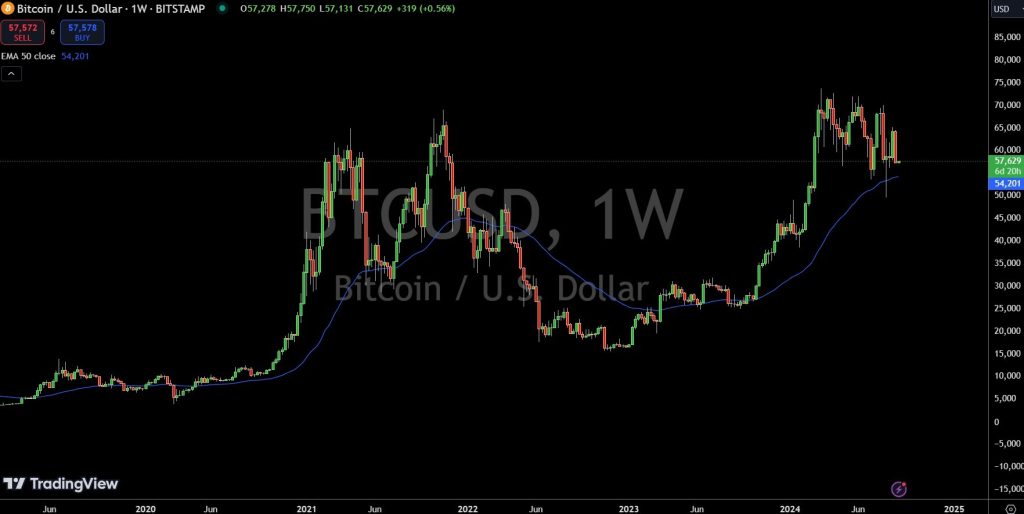
Bitcoin has experienced significant price movements throughout its history. It reached an all-time high of approximately $74,000 in 2024, showcasing its potential during peak market conditions.
In terms of price, Bitcoin often leads the market, trading at levels that reflect its dominance. While it has seen significant fluctuations, including notable peaks and corrections, Bitcoin’s long-term outlook remains strong. Some experts continue to predict substantial price growth as more investors and institutions view it as a reliable store of value in an increasingly digital economy.
2. Ethereum (ETH)
Ethereum is widely regarded as the strongest competitor to Bitcoin, offering extensive utility beyond just being a store of value or transaction medium. The Ethereum blockchain is specifically designed to allow developers to build scalable and secure decentralized applications (dApps), as well as to create entirely new cryptocurrencies.
This functionality is powered by smart contracts—self-executing agreements that operate without the need for a central authority. The conditions of these contracts are encoded directly into the blockchain, making them fundamental to innovations like decentralized finance (DeFi) and non-fungible tokens (NFTs).
Some industry observers have long speculated about the possibility of “the Flippening,” where Ethereum might surpass Bitcoin in market capitalization. As of now, Ethereum consistently ranks as the second-largest cryptocurrency, underlining its significant role in the market.
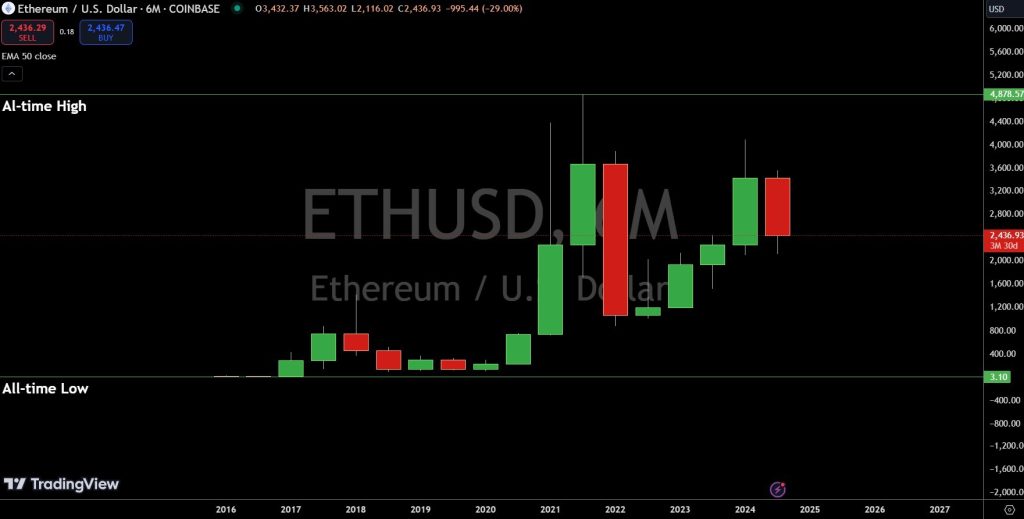
Ethereum is known for its faster transaction speeds and broader utility compared to Bitcoin. A key part of its ongoing evolution is Ethereum 2.0, a major upgrade designed to enhance the network’s capabilities. Ethereum 2.0 introduces more efficient scaling solutions, higher transaction speeds, and lower fees, while transitioning the network to a more sustainable proof-of-stake (PoS) consensus mechanism. This shift from the energy-intensive proof-of-work (PoW) model is aimed at making Ethereum more eco-friendly and better equipped to handle increased usage.
Ethereum has experienced significant price movements throughout its history. It reached an all-time high of approximately $4,878 in November 2021, reflecting its substantial growth potential during peak market conditions. Conversely, Ethereum has also seen notable lows, with its all-time low recorded around $0.43 in October 2015. These price fluctuations highlight Ethereum’s volatility but also its resilience and capacity for recovery.
In terms of value, Ethereum often trades at a fraction of Bitcoin’s price but has demonstrated substantial growth, with previous peaks nearing $5,000. While many cryptocurrencies have struggled to meet their potential, Ethereum remains a critical player in the crypto ecosystem. Its continued development, particularly through Ethereum 2.0, suggests that it will play a significant role in the market for years to come.
3. Cardano (ADA)
Cardano is a leading competitor to Ethereum, developed with the aim of addressing the challenges that earlier proof-of-work (PoW) blockchains, such as Bitcoin and Ethereum, faced—namely, issues related to scalability, flexibility, transaction speed, and energy efficiency.
Like Ethereum, Cardano leverages smart contracts to unlock the full potential of its network. What sets Cardano apart is its foundation in rigorous academic research and its emphasis on provable security, underpinned by strong mathematical principles.
Cardano’s development is structured and methodical, with updates released in phases, each named after historical figures. Notably, Phase 3 (Goguen) introduced smart contracts to the platform, significantly expanding its capabilities. The ongoing development includes the forthcoming Phase 4 (Basho), which is designed to enhance transaction speeds and further optimize the network’s performance.
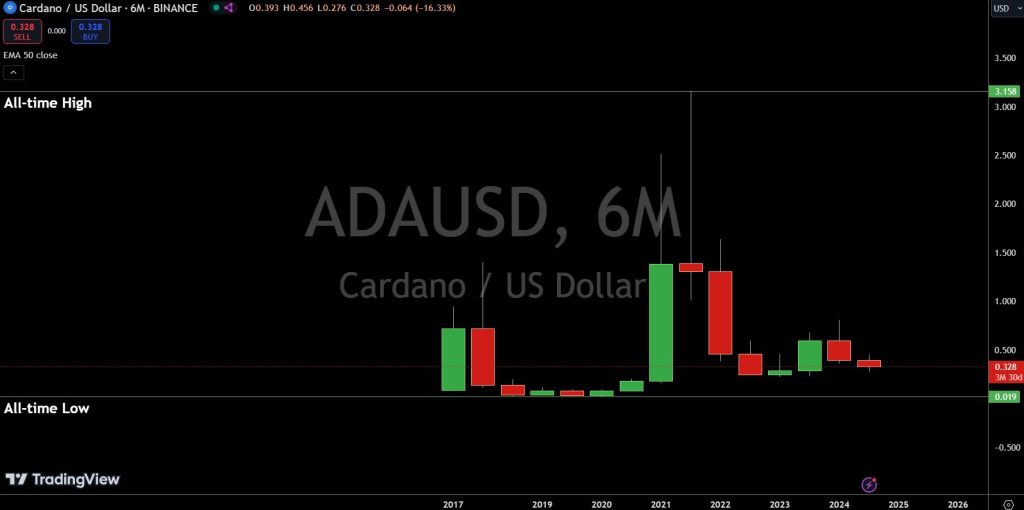
Cardano has experienced notable price movements throughout its history. It reached an all-time high of approximately $3.15 in September 2021, reflecting its potential during peak market conditions. Conversely, Cardano has also seen significant lows, with its all-time low recorded around $0.019 in March 2020. These price fluctuations highlight the volatility that is inherent in the cryptocurrency market.
With its robust fundamentals, active developer community, and a design that prioritizes regulatory compliance, Cardano is well-positioned for future growth. It remains a strong contender in the cryptocurrency market, consistently ranking among the top digital assets by market capitalization.
While its price has fluctuated—falling from its peak—Cardano’s long-term potential remains strong, offering considerable room for growth as its ecosystem continues to evolve.
4. Ripple (XRP)
XRP stands apart from Bitcoin and Ethereum as it is primarily designed to be an efficient medium for transactions. It offers a streamlined solution for transferring money, particularly in comparison to Bitcoin.
Developed by Ripple Labs, XRP was created to address a significant issue in traditional banking: the slow and costly process of cross-border money transfers. In conventional banking, international transactions can take days to process, with each intermediary bank adding time and fees.
XRP provides a faster and more cost-effective alternative. While Bitcoin transactions can take several minutes—especially during periods of high network activity—XRP transactions are typically confirmed within seconds at a minimal cost, often just a fraction of a cent per transaction, even for large sums of money.
Ripple Labs envisions widespread adoption of this technology by financial institutions and banks worldwide. However, ongoing legal and regulatory challenges have affected the adoption and price of XRP. Despite these obstacles, XRP continues to be a significant player in the cryptocurrency market, consistently ranking among the top digital assets by market capitalization.
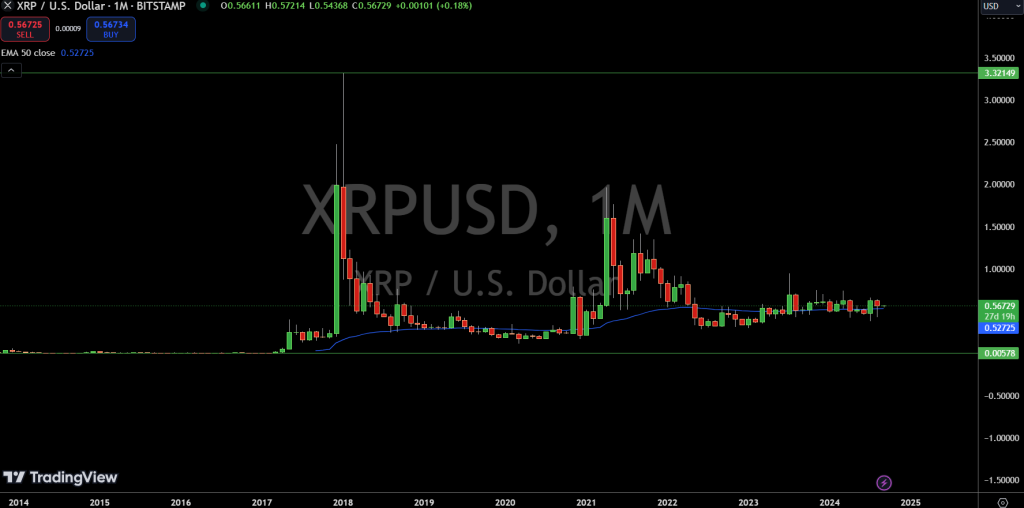
XRP has experienced notable price fluctuations throughout its history. It reached an all-time high of approximately $3.17 in January 2018, reflecting its potential during peak market conditions. Conversely, XRP has also seen significant lows, with its all-time low recorded around $0.0028 in July 2014. These price movements underscore the volatility inherent in the cryptocurrency market.
The future of XRP largely hinges on the resolution of its regulatory challenges. If these issues are resolved favorably, XRP could experience substantial growth in adoption and value. Despite its price fluctuations, XRP holds the potential for long-term growth as it aims to reshape the way money is transferred globally.
5. Polkadot (DOT)
Polkadot is a relatively new entrant in the cryptocurrency space but quickly gained popularity with investors. Unlike many cryptocurrencies that focus on specific use cases, Polkadot is designed to enhance the infrastructure of the entire cryptocurrency ecosystem.
In the crypto world, three primary challenges exist: speed, security, and scalability. Polkadot addresses these issues through the use of parachains—specialized blockchains that enable different blockchains to interact seamlessly. The DOT token is essential for validating transactions across the network and for voting on the network’s future direction.
Polkadot is at the forefront of innovation in this space, with millions of transactions already processed on its parachains. Currently, Polkadot can handle approximately 1,000 transactions per second, with the potential to scale to 1 million transactions per second in the future.
Like Ethereum, Polkadot encourages developers to build decentralized apps (dApps) and new cryptocurrencies on its platform. Despite being relatively new, Polkadot has shown impressive growth and appears poised to remain a key player in the cryptocurrency ecosystem.

Polkadot reached an all-time high of approximately $55.13 in November 2021, reflecting its strong performance during peak market conditions. Conversely, Polkadot has also seen lows, with its all-time low recorded around $3.56 in December 2022. These price movements highlight the volatility inherent in the cryptocurrency market.
While DOT currently ranks around #11 among the top cryptocurrencies by market capitalization, its future looks promising. The Polkadot team has raised around $200 million across two sales in a short span, making it one of the most well-funded crypto projects ever.
6. Solana (SOL)
Solana is similar to Ethereum and Polkadot in its aim to create a robust ecosystem for developers to build on. However, Solana introduces a unique approach that could drive it to new heights in the coming years.
Solana’s primary objective is to enable developers to create scalable and secure decentralized applications (dApps) on its blockchain. What sets Solana apart is its innovative focus on demonstrating that a set of algorithms can eliminate software as a bottleneck, making bandwidth the only constraint. In simpler terms, Solana is designed to maximize efficiency and speed on its network.
Currently, Solana supports around 50,000 transactions per second (TPS). Theoretically, on a standard gigabit network, this number could increase to 710,000 TPS; on a 40-gigabit network, this could soar to 28.4 million TPS. For context, Visa can process around 24,000 transactions per second, with potential peaks at 65,000 TPS.
This impressive scalability is achieved through a concept called Proof of History (PoH), which effectively creates a synchronized clock across the blockchain. Unlike networks without a synchronized clock—such as Bitcoin and Ethereum—that struggle with scalability, Solana’s PoH addresses these issues directly.
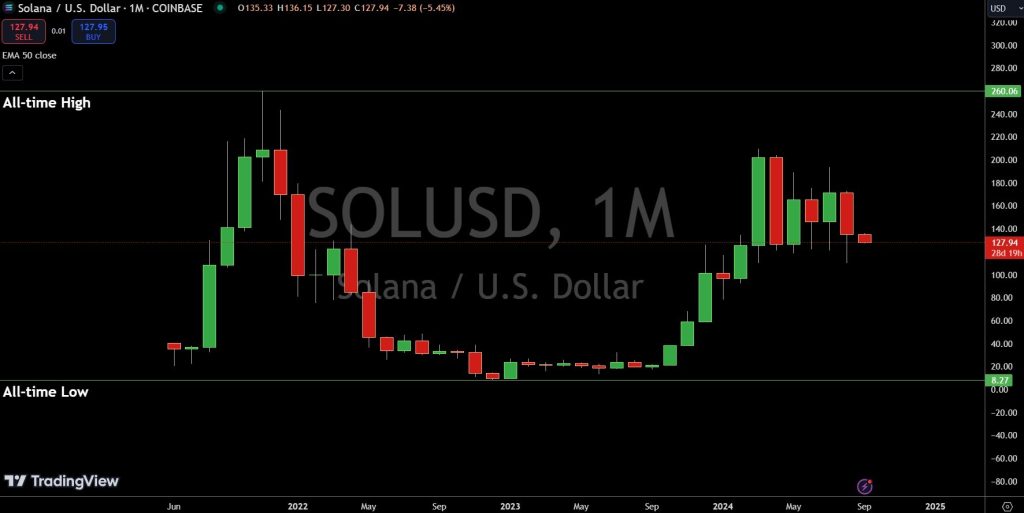
As a result of its innovative approach, SOL experienced remarkable growth in 2021, surging from $26 to an all-time high of approximately $260.06 in November 2021. Conversely, Solana’s all-time low was around $8.27 in December 2020.
These price movements reflect the volatility inherent in the cryptocurrency market. If Solana’s technology continues to gain adoption, it has the potential to challenge Ethereum as the leading platform for decentralized applications and smart contracts.
7. Polygon (MATIC)
Polygon is a scaling solution that, like Polkadot, enables blockchains to connect and operate efficiently at scale. However, Polygon is specifically designed as an Ethereum-based solution, operating on the Ethereum blockchain and facilitating connectivity with Ethereum-based projects.
Polygon enhances the Ethereum ecosystem by providing decentralized applications (dApps) with various scaling solutions, helping to alleviate congestion on the Ethereum blockchain. This capability has made Polygon a key player in several DeFi applications where speed is crucial. As a result, the success of Ethereum is directly linked to the growth and utility of MATIC.
There have been concerns that Ethereum 2.0 might overshadow projects like Polygon. However, it’s important to note that Ethereum 2.0 will implement sharding (a process that breaks up transactions), while Polygon uses rollups (bundling transactions together). These differing approaches suggest that Polygon will continue to play a complementary role within the Ethereum ecosystem, rather than being replaced by Ethereum 2.0.
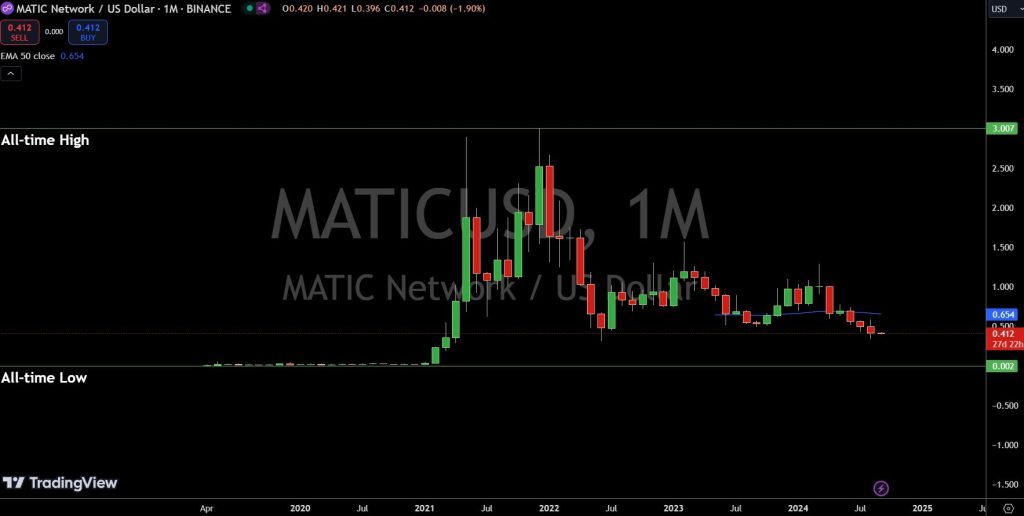
Due to its robust role within the Ethereum ecosystem, Polygon is expected to continue growing. It reached an all-time high of approximately $3.00 in December 2021, reflecting its strong performance during peak market conditions. Conversely, Polygon’s all-time low was around $0.002 in May 2019. These price fluctuations highlight the volatility inherent in the cryptocurrency market.
MATIC has demonstrated resilience, retaining much of its value even after its substantial growth from early 2021 when it was worth around $0.03. As the Ethereum network continues to expand, MATIC is expected to grow alongside it.
8. Uniswap (UNI)
Uniswap is a decentralized marketplace for trading ERC-20 tokens built on the Ethereum blockchain, enabling transactions without the need for a third party. As an open-source blockchain, anyone can view and contribute to its code, promoting transparency and innovation.
Using smart contracts, Uniswap has gained significant popularity because of its wide range of tokens that aren’t typically seen on centralized exchanges. Users can create new markets, trade pairs that have never been seen before, and participate in the platform’s governance using the native token, UNI.
One of the key benefits of Uniswap’s decentralized nature is its resistance to hacking and mismanagement. Additionally, it lacks the high fees often associated with centralized exchanges. To address the fundamental liquidity challenges in decentralized exchanges, Uniswap allows users to swap their tokens without the need for buyers and sellers to provide liquidity, thanks to its automated market maker (AMM) model.
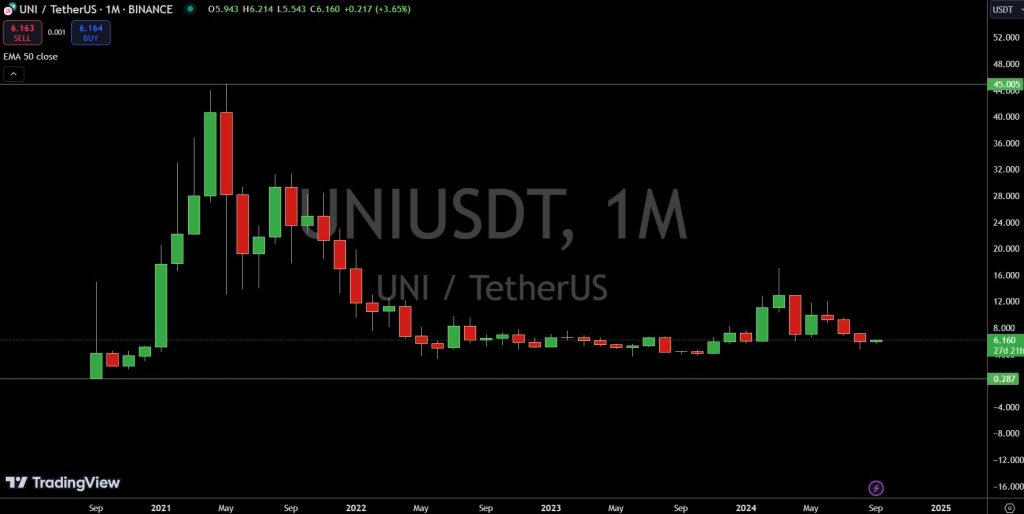
Uniswap remains a strong contender in the crypto space, especially as more users seek out tokens that are not yet available on centralized exchanges. As cryptocurrency adoption continues to grow, Uniswap is well-positioned to attract more users and expand its influence.
Uniswap reached an all-time high of approximately $45.00 in May 2021, showcasing its potential during peak market conditions. Conversely, Uniswap’s all-time low was around $0.29 in November 2020. These price movements underscore the volatility inherent in the cryptocurrency market.
Given Uniswap’s popularity and the growing number of competitors in the decentralized exchange space, we remain optimistic about UNI’s potential. As the crypto market becomes more mainstream, Uniswap is likely to continue its upward trajectory, attracting users who seek decentralized and innovative trading solutions.
9. Litecoin (LTC)
Litecoin is one of the oldest and most established projects in the cryptocurrency space, having launched in 2011. It was created by making several modifications to Bitcoin’s open-source code, which led to its recognition as one of the first altcoins. If Bitcoin is often referred to as “digital gold,” Litecoin is commonly known as “digital silver.”
Litecoin shares several similarities with Bitcoin, including a limited supply—though Litecoin’s cap is set at 84 million coins, compared to Bitcoin’s 21 million—and the use of a proof-of-work (PoW) consensus algorithm.
One of the main reasons Litecoin remains popular is because it offers many of Bitcoin’s benefits, such as decentralization and security, but with faster transaction speeds and lower costs.
Litecoin typically processes transactions in about 2.5 minutes, with transaction fees that are generally around $0.007, making it a faster and more cost-effective alternative to Bitcoin.
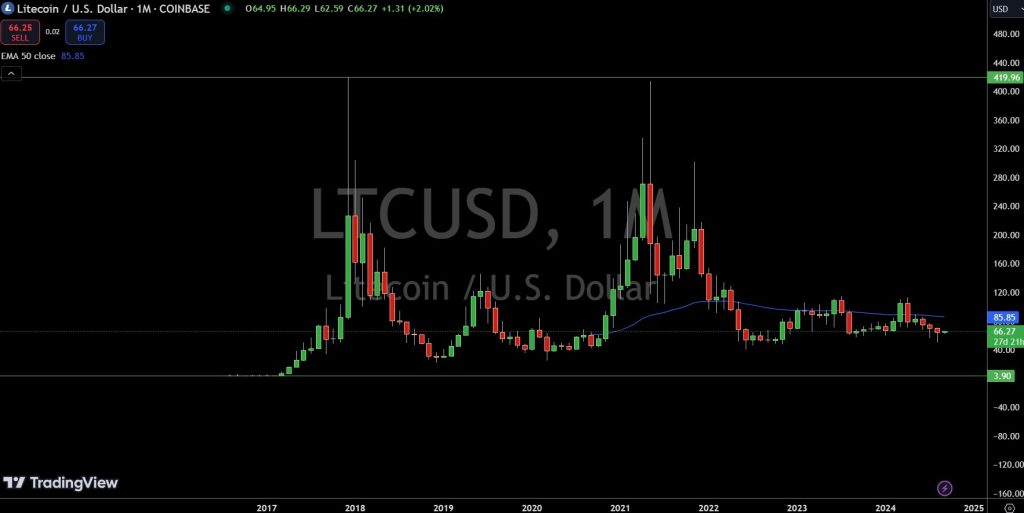
Despite its age and more limited use cases compared to some newer cryptocurrencies, Litecoin continues to hold a strong position in the market. It reached an all-time high of approximately $419.96 in December 2017, reflecting its potential during peak market conditions. Conversely, Litecoin’s all-time low was around $3.90 in January 2015. These price movements underscore the resilience of Litecoin and its continued relevance in the cryptocurrency space.
Litecoin’s longevity, proven concept, and close relation to Bitcoin make it a solid option for those looking to diversify their crypto portfolio with a well-established asset.
10. TRON (TRX)
TRON is a decentralized, blockchain-based operating system known for its smart contract functionality and proof-of-stake consensus algorithm. It was founded in 2017 by Justin Sun and has since grown into one of the more prominent cryptocurrencies in the market, with its native token, Tronix (TRX), at the center of its ecosystem.
Originally launched as an Ethereum-based ERC-20 token, TRON migrated to its own blockchain in 2018, marking a significant milestone in its development. This transition enabled TRON to operate independently and introduced the TRC-20 standard, which facilitates fast and low-cost transactions within the network.
One of TRON’s key achievements is the acquisition of BitTorrent in 2018, a major peer-to-peer file-sharing platform. This move expanded TRON’s reach and integrated decentralized storage capabilities into its ecosystem.
TRON’s vision is to create a decentralized internet where users can freely create and share content without relying on intermediaries. This ambition has led to the development of various decentralized applications (dApps) and services within its network.
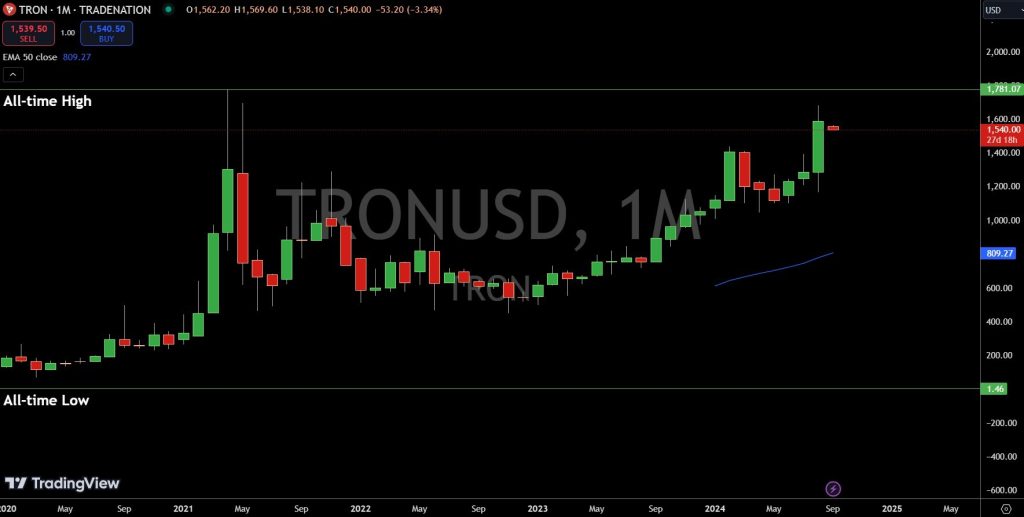
TRON reached an all-time high of approximately $1,781 in late 2024, demonstrating its potential during peak market conditions. On the other hand, its all-time low was around $1.46, reflecting the early stages of its development.
Despite some regulatory challenges, including a lawsuit by the U.S. Securities and Exchange Commission (SEC) in 2023, TRON has continued to thrive, becoming a significant player in the blockchain space. As the demand for decentralized solutions grows, TRON is well-positioned to capitalize on this trend, making it a strong candidate for future growth.
Conclusion
The long-term trajectory of the cryptocurrency market remains bullish, even amidst periods of market downturns. Many of the projects highlighted in our list may currently be trading at what could be considered significant discounts, presenting potential opportunities for savvy investors.
However, it’s essential for anyone looking to invest in cryptocurrencies to practice proper risk management and only invest what they can afford to lose. The cryptocurrency market is known for its volatility, which may be unsettling for those more accustomed to traditional financial markets.
For those who believe in the growth and future of cryptocurrencies, a buy-and-hold approach could be a prudent approach. If you’re uncertain about which cryptocurrencies to invest in, diversifying your holdings across several different assets could help spread risk, much like an investor would with a varied stock portfolio.
To get started with crypto trading today, take a look at these top cryptocurrency brokers or deepen your knowledge with our explainer article on what cryptocurrency is.
